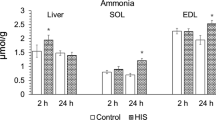Abstract
Consumption of a meal is followed by an increase in cardiac output (CO) which appears to be closely related to the concomitant increase in blood flow to the gastrointestinal organs. To gain information on the mechanism behind this increase in CO we have previously used Doppler ultrasound technique to record circulatory responses to a standardized meal in five patients with recently transplanted and thus denervated hearts. We obtained the surprising result that they reacted to the consumption of a meal with a greater increase in CO than did five matched normal controls. The patients also presented above-normal levels of heart rate (HR) and CO at rest. The same five patients have now been tested 18 months later to re-examine their remarkable cardiac response to ingestion of a meal. The hearts of two patients showed some signs of reinnervation, whereas the hearts of the other three were apparently still fully denervated. However, all five patients once again evolved a marked cardiac response to ingestion of a meal. Postprandial CO reached significantly higher levels in the patients than in the controls. The persistence of such a pronounced postprandial augmentation of CO in transplanted and largely denervated hearts strengthens the assumption that the heart is induced to increase its postprandial performance through the action of a humoral agent of some sort, possibly one of the hormones from the duodenal-pancreatic region


Similar content being viewed by others
References
Baron AD (1994) Hemodynamic actions of insulin. Am J Physiol 267:E187–E202
Eriksen M, Walløe L (1990) Improved method for cardiac output determination in man using Doppler technique. Med Biol Eng Comput 28:555–560
Gladstone SA (1935) Cardiac output and related functions under basal and postprandial conditions. Arch Intern Med 55:533–546
Gunnes P, Smiseth OA, Lygren I, Jorde R (1985) Effect of secretin infusion on myocardial performance and metabolism in the dog. J Cardiovasc Pharmacol 7:1183–1187
Gunnes P, Waldum HL, Rasmussen K, Østensen H, Burhol PG (1983) Cardiovascular effects of secretin infusion in man. Scand J Clin Lab Invest 43:637–642
Moneta GI, Taylor DC, Helton WC, Mulholland MW, Strandness DE Jr (1988) Duplex ultrasound measurement of postprandial intestinal blood flow: effect of meal composition. Gastroenterology 95:1294–1301
Qamar MI, Read AE (1988) Effects of ingestion of carbohydrate, fat, protein and water in the mesenteric blood flow in man. Scand J Gastroenterol 23:26–30
Rowell LB (ed)(1993) Human cardiovascular control. Oxford University Press, Oxford, pp 205–207
Toska K, Eriksen M (1993) Respiration-synchronous fluctuations in stroke volume, heart rate and arterial pressure in humans. J Physiol Lond 472:501–512
Waaler BA, Eriksen M (1992) Post-prandial cardiovascular responses in man after ingestion of carbohydrate, protein or fat. Acta Physiol Scand 146:321–327
Wesche J, Orning O, Eriksen M, Walløe L (1998) Electrophysiological evidence of reinnervation of the transplanted human heart. Cardiology 89:73–75
Waaler BA, Eriksen M, Janbu T (1990) The effect of a meal on cardiac output in man at rest and during moderate exercise. Acta Physiol Scand 140:167–173
Waaler BA, Eriksen M, Toska K (1991) The effect of meal size on postprandial increase in cardiac output. Acta Physiol Scand 142:33–39
Waaler BA, Hisdal J, Eriksen M (2002) Ciculatory responses to a meal in patients with a newly transplanted heart. Acta Physiol Scand 174:101–108
Acknowledgments
The authors would like to thank Torun Flatebø for expert technical assistance and careful handling of the patients, and Professor Lars Walløe for valuable advice and for selecting statistical methods and performing the statistical analyses. The study was supported by grants from the Research Council of Norway and the Foundation of the Family Blix.
Author information
Authors and Affiliations
Corresponding author
Rights and permissions
About this article
Cite this article
Waaler, B.A., Hisdal, J., Ihlen, H. et al. Mechanisms behind the postprandial increase in cardiac output: a clue obtained from transplanted hearts. Eur J Appl Physiol 97, 516–520 (2006). https://doi.org/10.1007/s00421-006-0210-0
Accepted:
Published:
Issue Date:
DOI: https://doi.org/10.1007/s00421-006-0210-0




